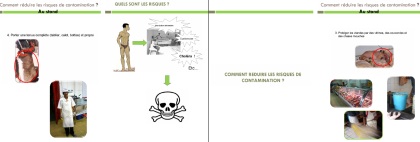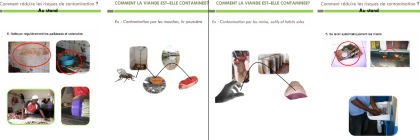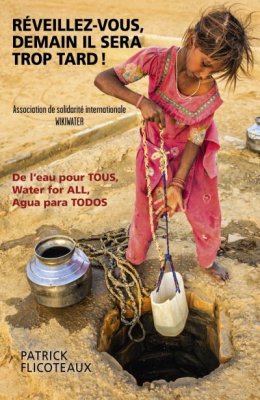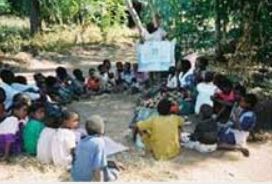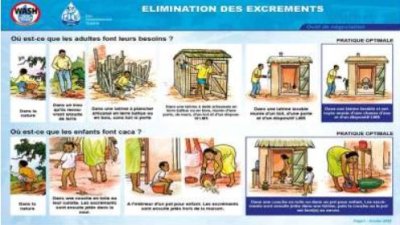It is recommended that you first consult data sheet C1 "General principles and methods of education and awareness as to hygiene and health issues"
1) What is involved ?
The specific guidelines method is one of the main methods for which the general principles have been covered in data sheet C1. The Goal of these methods is to associate and involve the populations for sustainable sanitary development. This method is particularly intended for merchants in urban or peri-urban areas but it can be expanded to other professions and to rural areas.
2) Who use this means and since when ?
This method has been in use since the 1970s in all of the developing countries.
3) Why ?
Providing access to water or sanitation is not enough if the population does not have a minimum understanding of notions in hygiene and do not assimilate the solutions that are found to reach this.
The populations involved have to be made interested, educated and made accountable for the stakes concerning the healthy and sustainable management of the hygiene and health problems in relation to water or sanitation.
This data sheet explains the implementation, advantages and disadvantages of the specific guidelines method. But the reader must keep in mind that other methods do exist (in particular those described in data sheets C1 to C3) or can be created and that there is no universal method : the reader must constantly try to adapt or get inspiration from these methods rather than try to apply them as they are in order to provide a satisfactory response to each situation, which is necessarily unique.
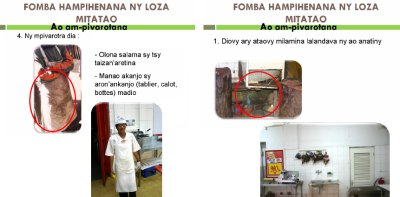
AAST Association : hygiene guide for butcher shops, Malagasy version. 
4) Who is primarily concerned ? Locations or contexts in which this means seems best suited
Firstly, all populations that do not have satisfactory access to water and sanitation, without excluding those however that already have access.
At the outset, such programmes were created to assist des community groups (rural villages, small towns, etc.), as it is easier to involve a limited number of people and members of the same group or community. However, awareness and educational campaigns can also be set up on a wide scale.
5) What does this method involve ? How is it used ?
The principle with this method is to adapt the awareness message according to the profession of the addressees (butchers, bakers, garage owners, fruit sellers, etc.) or to the equipment that the message refers to (guide for using public fountains, latrines, etc.).
The message therefore can be more targeted and as such have more impact, and the reader will feel even more concerned if the message refers either to his profession or to the equipment that he wants to use.
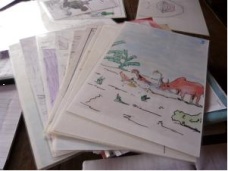 After a brief reminder (two or three lines) of the objectives of the guide, the latter can contain two parts :
After a brief reminder (two or three lines) of the objectives of the guide, the latter can contain two parts :
- A first informative and slightly theoretical part – on the legislation in effect, hygiene and microbes – including concrete examples and illustrations with regards to the objective of the guide, profession or equipment.
- A second more practical part on the gestures and behaviours to adopt and those to be avoided in the premises in question, in the market or during the use of the equipment that the guide refers to.
It is very important that these guides include a maximum number of photos, illustrations and contain clear and concise summaries so that they can be understood by as many people as possible, in particular by people who are practically illiterate.
6) Special difficulties and remedies and/or precautions to be taken
To be effective, the duration of the awareness period must be at least one year, even if the methods can last for a much shorter time. People must therefore be trained who will continue to increase awareness of their fellow citizens once the methods have been carried out.
Two points are fundamental in order to projects to be a success. On the one hand, the behaviour of the leaders who, while being present, place the community at the centre of the action and discussions (the leader is an enlightened facilitator). On the other hand, the development of a toolkit that takes the cultural characteristics of the communities into account and is updated and given life by the leaders.
7) Main advantages and drawbacks
a) Advantages
1. As the guides are specific, they do not contain any superfluous information, the reader therefore really feels concerned.
2. Guides intended for specific professions (butchers, bartenders, etc.) can contain some technical information which would not be appropriate in a guide intended for the entire population. Specific guides are therefore more thorough.
b) Disadvantages
These guides are not entirely suited for the illiterate. The many pedagogical illustrations are there in order to limit this disadvantage as much as possible.
8) Cost
The cost of a one-year awareness campaign is estimated to be a few thousand Euros (€5000 to 6000) for 10,000 inhabitants. For example, the women employed by the EAST association in Africa are paid, in light of the low levels of remuneration locally, €2 for eight days of work per month (they scrub the waste water channels and also act as informants) and a little less than 100 people are needed for a town of 10,000 inhabitants.
Of course this cost can very substantially but a cost of about €1 for two inhabitants can be retained. This cost can become more affordable if grants are obtained or if any revenue can be derived from the measures set up. As such, the salary of the women paid by EAST comes in part from revenues from the public latrines installed by the association.
It is also very important when setting up budgets to take inflation rates into account, as these can be very high in certain developing countries.
9) Achievement example
The EAST association directed by Doctor MONJOUR has developed specific sanitary guides intended for certain merchants in Madagascar. The images below are extracts from two of them, the one intended for butcher shops and the other intended for "gargottes" (the local grocery shops)
Hygiene guide for butcher shops 


Hygiene guide for "gargottes"
10) Observations and recommendations
These methods are not of course miracle recipes and often they are only tools participating in a more global approach. It is in particular essential before starting a project to have three surveys taken by specialists :
- A survey on the existing situation : sanitary, technique, economic (then require participation that is in line with the means) and political (know the forces that exist at the local level, in particular the town hall).
- A survey on the knowledge of the population, its level of education.
- A survey of the Ethno-sociological type on the practices, customs and behaviours of the population.
11) Where to obtain further information - Bibliography
a) Websites
- French Red Cross
"Awareness, information and education of populations on water problems Guide to methods". Document available (online) at :
http://infodoc.agroparistech.fr/index.php?lvl=publisher_see&id=28208
- Multimania : Examples of use of various participatory methods in Africa :
http://membres.multimania.fr/soular...
b) Bibliography
UNICEF Handbook on Water Quality
New York, 2008
UNICEF_in English_ Booklet on Water quality and the promotion of HYGIENE _pages 76 to 84_WQ_Handbook_final_signed_16_April_2008



